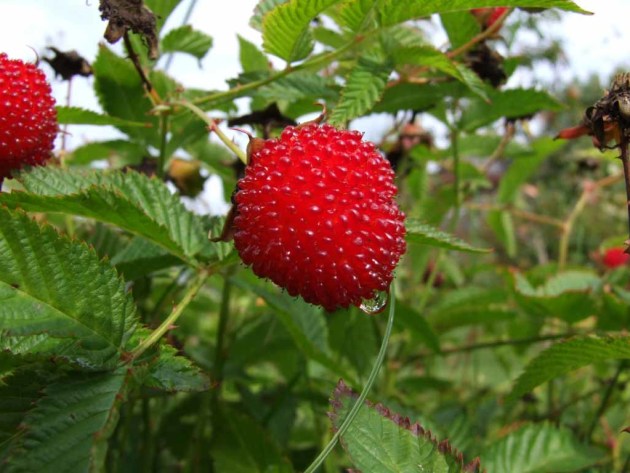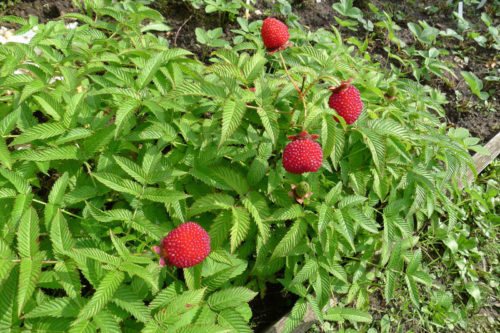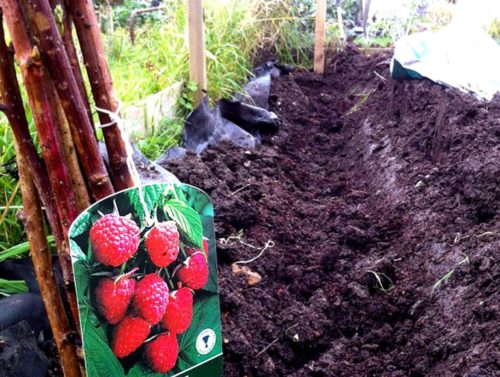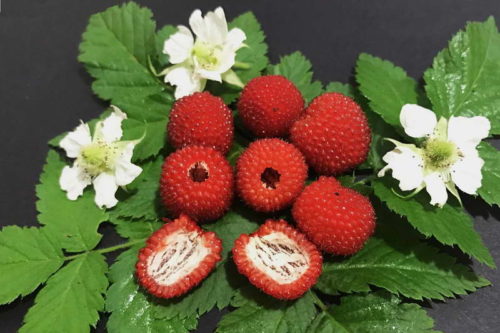Assortment of garden semi-stars bringing a rich harvest of berries today is so great that sellers in order to attract buyers give plants sonorous and tempting names. In this way, the market is filled with an appetizing strawberry-raspberry, raspberry-black-based hybrids, and now the Norwegian Malina. What is hiding under the name "Norwegian Malina", what advantages and disadvantages of this type of raspberry? How is Norwegian raspberry grown, what care is required by this plant? In the article, we will try to give exhaustive answers to all these questions.
Norwegian Malina, description
"Norwegian Malina" is just a trade name, not a separate raspberry species. Such a raspberry appeared in Norway, where a long time was taken by the selection of the best copies of the usual raspberry of the seductive (RUBUS ILLECEBROSUS).
According to sellers, Malina from Norway owns an excellent taste, perfectly fruits and does not create special difficulties in the process of cultivation. Such advantages of Raspberries received thanks to the harsh Norwegian climate. In addition, during the selection of decent species and their further selection, it was possible to obtain winter-hardy bushes with a height of up to 100 cm, while common raspberries, as a rule, it does not grow above 60 cm and does not tolerate a harsh climate.
Description of the Norwegian raspberry:
- It is a semi-staple with a creeping and fast-growing rhizome. Raspberries quickly captures nearby territories, forms thick thickets.
- A bush consists of several reprehensive shoots that weigh only at the base, and the rest is covered with greenish bark.
- Conductural foliage is located alternately, sits on the stiff, the form of the sheet oval-lanceal, length from 3 to 8 cm. All shoots and cutters are thickly covered with spines.
- White colors, five-pack, flower diameter 4 cm.
- The berry is multicreave, in diameter up to 5 cm, round form or slightly elliptical. The berry color is coral red, ruby. Taste - sour-sweet, pulp - juicy and very fragrant.
- Fruit lengthy, up to frost. Flowering and fruiting is continuous, so on the bush you can contemplate the simultaneous maturation of delicious berries and dissolve in fragrant colors. The last harvest is collected in November.
- For the winter, there is a dying of the above-ground part, which is completely restored in the spring.
- The reproduction of the Norwegian raspberry occurs in the vegetative method. It is impossible to grow from seeds Norwegian raspberries with all varieties.
Malina Norwegian has a number of features that should be taken into account before starting to cultivate this culture. If it comes to the disadvantages and advantages of Norwegian raspberries, the reviews about this plant are told about the following:
- Malina Norwegian can boast of delicious berries in a saturated color, they are rather large, shiny, sweet. Nevertheless, many are not delighted with its taste, considering it more water and refreshing, rather than ordinary raspberries.
- Very small raspberry saplings of the Norwegian raspberry seedlings come on sale, so the first fruiting has to wait three and even four years. In the first years, Kustik is actively increasing the roots, and only when it is growing, it starts fruit. While ordinary raspberries pleases berries 2-3 years earlier.
- Norwegian raspberries are extremely barbed. This is a fairly significant drawback, so this plant is still not very popular. Caring for her is complex, because it is necessary to work in special gloves.
- The advantage of the plant can be called the presence of immunity to most diseases and pests. In addition, raspberries are not amazed by slugs due to sharp spines.
- Norwegian Malina Capripant in terms of agrotechnology, so the abundance of fruiting depends on high-quality raspberry care. If the care is carried out ineptly, the crop will not work.
Norwegian raspberry, landing and care
Norwegian variety of raspberries needs certain conditions of cultivation, it is necessary to carefully care for it, otherwise the fruiting will be short and scanty.
Norwegian raspberries, climatic conditions and soil requirements
- It is possible to grow raspberries in the sun, as in the sun and in a modest one.
- It is advisable to plant bushes in light loams whose acidity is 6.6-7.5.
- The soil must be moderately fertile. To achieve the desired level of fertility, you can deposit a mineral agent for berry crops before boarding.
- To limit the growth of the root system, which can capture more than meters around itself, raspberry is better to plant on a slightly raised edged ridges.
Landing of Norwegian raspberry
- Given the degree of growth, between the raspberries are withstanding the distance of 80-120 cm. High landing density reduces yield.
- Before planting around the landing pit, restrictions create restrictions using slate sheets or plastic. It is necessary that the roots of the bush do not scatter around the site.
- For a seedling, you prepare a shallow yam up to 10 cm, since its root system is located superficially.
- Rhizome deepens, cheer and pour themselves. After landing, the seedlove is shared.
- Over the next 14 days, the soil is moisturized daily. After the end of this period, the bush no longer needs special care.
On a note! Norwegian raspberry seedlings are rooted in 98% of cases. If the bushes were placed in unfavorable conditions, the plant spends all the forces on rooting, and the above-ground part will soon die.
Features of the care of Norwegian Malina
- Norwegian raspberries require an average level of humidity. Watering is carried out during drought. Raspberries on the irrigation of the leaves (flowers to water is undesirable). The drying of the soil in the attractive circle should be excluded.
- The needs of the raspberry are modest, but it is still necessary to make fertilizers. Source quite in spring and at the time of blooming is made liquid minudging. Or annually in spring time to feed the bushes with a granular fertilizer for berries.
- Malina prefers to warm the rays of the sun, while its rhizome should sit in cool soil. To provide plants such conditions, the rolling circle is mounted with a compost. However, the compost and other organic acids boil the soil, so 50 g of dolomite flour for each square meter is necessarily plated under the mulch.
- Since the above-ground part of the raspberry is late in the fall, after the end of fruiting is carried out sanitary trimming. In the regions where the winter temperature exceeds -29⁰, trimming is carried out in early spring, so that the plant can survive the winter, and its root system does not extinate.
Norwegian raspberry, reproduction
In the spring, all raspberry stalks are actively growing from the kidneys on the roots. Thanks to this property, Norwegian raspberries easily determine the division of the bush. Separate part of the bush early in spring or late autumn. Choose part of the root with the kidney. Only the plants of the third year of life are separated.
Norwegian raspberry, diseases and pests
- Norwegian raspberries rarely suffer, and if it happens, its above-ground part is affected by mildew. The cause of the disease is an excess of moisture and a bidding of landing. Copper vitriol is used as treatment.
- A yellow mosaic is also found, which is not amenable to treatment, and the bushes have to destroy.
- From bacterial diseases, chlorosis and root cancer can be distinguished. In this case, it is necessary to remove all the affected parts of the raspberry.
- More often, Norwegian raspberries is damaged by pests. It may be a weevil or a raspberry beetle. To destroy insects apply carboofos.





















 Start a discussion ...
Start a discussion ...